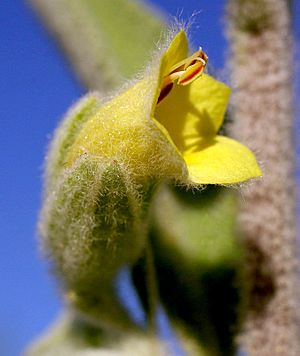Muniria facts for kids
Quick facts for kids Muniria |
|
|---|---|
 |
|
| Flower of Muniria quadrangulata | |
| Scientific classification |
|
| Kingdom: | Plantae |
| Clade: | Tracheophytes |
| Clade: | Angiosperms |
| Clade: | Eudicots |
| Clade: | Asterids |
| Order: | Lamiales |
| Family: | Lamiaceae |
| Subfamily: | Prostantheroideae |
| Genus: | Muniria N.Streiber & B.J.Conn |
| Species | |
|
See text |
|
Muniria is a group of four kinds of flowering plants. They belong to the mint family, called Lamiaceae. You can only find these plants in the Northern Territory in Australia.
Plants in the Muniria group are fuzzy shrubs. Their flowers have five petals that are joined together to make a tube shape. Each flower also has four stamens (the parts that make pollen) that are different lengths.
These plants look a lot like those in another group called Pityrodia. But Muniria plants have branches that are clearly square-shaped when you look at them from the side. Also, their fruit has special bumps or ridges.
What Muniria Plants Look Like
Muniria plants are evergreen shrubs, which means they keep their leaves all year round. They usually grow to be about 1 to 2 metres (3 to 7 feet) tall. They are covered in thick, soft, woolly hairs.
Their stems and branches are shaped like a square when you cut across them. The leaves are simple, meaning they are not divided into smaller leaflets. They are shaped like an oval or an egg. The leaves grow in pairs, one on each side of the stem, and are also covered with woolly hairs and tiny glands (which are like small bumps that can produce sticky stuff).
The flowers grow either by themselves or in groups of up to twelve. They appear where the leaves meet the stem, which is called a leaf axil. Each flower or group of flowers is surrounded by small, leaf-like parts called bracteoles.
Each flower has five sepals, which are like small leaves that protect the flower bud. These sepals are joined together for about half their length, forming a tube with five tips. The five petals are pale yellow to red. They form a slightly curved tube with five tips at the end. The top tips are a little shorter than the bottom ones. Inside the flower, there are four stamens. The two lower stamens are shorter than the two upper ones.
When the flower turns into fruit, it becomes dry. This fruit does not open up to release its seeds when it's ready. Instead, it has special ridges or calluses (hardened bumps) on it.
How Muniria Got Its Name
The Muniria group of plants was first officially described in 2011. This was done by two scientists, Nikola Streiber and Barry Conn. They published their description in a science journal called Australian Systematic Botany.
The main plant that represents this group is called Muniria quadrangulata. This plant was first described in 1979 by another scientist named Ahmad Abid Munir. At that time, he named it Pityrodia quadrangulata.
Later, in 2011, Barry Conn, Murray Henwood, and Nikola Streiber decided that P. quadrangulata and three other plants from the Pityrodia group were different enough to be put into a brand new group. They named this new group Muniria, likely in honor of Ahmad Abid Munir.
As of March 2020, the Australian Plant Census (which keeps track of all Australian plants) recognizes four species in the Muniria group:
- Muniria angustisepala (Munir) N.Streiber & B.J.Conn
- Muniria lanceolata (Munir) N.Streiber & B.J.Conn
- Muniria megalophylla (Munir) N.Streiber & B.J.Conn
- Muniria quadrangulata (Munir) N.Streiber & B.J.Conn
Where Muniria Plants Live
All four types of Muniria plants are found only in the Northern Territory of Australia. They don't grow naturally anywhere else in the world.
See also
 In Spanish: Muniria para niños
In Spanish: Muniria para niños

